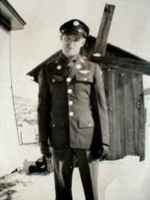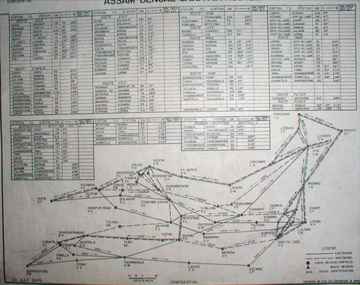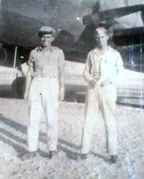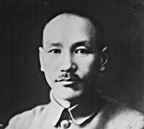|
This is about WWII, Flying the Hump, and simply
existing in India. Our training for Hump flying was at, Reno Nevada
AAF Base. Its purpose was to train us, both Pilots and Radio Operators,
in high terrain flying over the Rockies. For us, boys from the east,
this was awesome! We flew night and day. On one trip we got a real taste
of the problems we would be facing. We had spent the night at Sacramento.
Getting in there late, the mess hall had already closed so we borrowed
a staff car and went off base looking for something to eat. The proper
way to close down an aircraft at night was to top off the fuel tanks.
Otherwise, condensation would settle in the tanks. Sadly, we waited
to fill up the next morning. Over the Rockies on our way back ourengines
sputtered and stopped. After some frantic checking, we were told to
prepare to jump, and after what seemed like hours, they coughed and
started.
| On completion of this training, we were
assigned to India. The picture of me there was taken the day before
I left.My wife was expecting at anytime and our Doctor asked for
an extension of my leave but was refused. Three days later my son
was born; he would be a year old before seeing his Dad. Twelve of
us flew over together after picking up our plane at Berry Field,
Nashville, Tennessee and we then flew to Morrison Field in Florida
where we were equipped for the trip. We were issued parachutes and
Colt 45 pistols. The trip over was via South America and Africa
– destination Karachi, India. There, they gave us many many
shots and, to our surprise, took away our parachutes! All of our
trips after that were without parachutes. With this change, we went
on to Barrackpore (about |
 Just before leaving
home for India.
Just before leaving
home for India.
Click image for larger view |
30 miles above Calcutta.) Two things you never get used to in India were
the heat and stench. Most of our trips to China, destination mostly Kunming,
were night flights to get us there in the morning. We were on the ground
at Kunming for about a 2 hour offload then back in the air, west bound,
a total time of 12 to 14 hours. We were a pretty tired crew when we landed.
Because of this schedule, sleeping was mostly during the day. We slept
on hemp rope cots wrapped inside a mosquito net. Sleep came slow with
the temperatures in the 105 range and the humidity very high. Our quarters
in India were large thatched huts called basha with about 16 men in each.
We had a Hindu Indian bearer to keep things somewhat livable. One of the
guys got some cans of tomato juice which he opened and passed it around.
Raj, our bearer saw the color and thought that we were truly American
Blood drinkers and fled from the basha. It took a lot of coaxing and someone
who spoke his language to explain that it was Tomato Juice - not blood.
 T his
is some of my basha buddies. I'm back row left. The Indian in
front is our bearer.
Click image for
larger view |
On one of my trips into Calcutta, I spotted
an ice cream maker, the old hand cranked type. I bought it and took
it back to the basha. A little late, I figured out it wasn't a whole
lot of good without something to make ice cream with. I sent an
SOS, via V-mail, back to my wife in the States requesting ice cream
mixes. About two months later I received a package from Heaven with
several, mostly Vanilla. Everything else we needed, mostly salt,
we could get at the mess. We decided it should have a little fruit
of some kind. Bananas were easy to get so I gave Raj one rupee note
worth about 30 cents to get some. He looked at me kinda funny but
took off on the quest and came back with all the bananas he could
carry - far more than we needed and gave me back change. The Ice
Cream was delicious and shared by all. |
On my off days, when not flying, I worked the briefing room, keeping all
the information up to date and typing the weather codes for the next day.
This was always done late at night so the duty was until 5:00 in the morning.
One night two pilots from the Upper Assam Valley came in and asked me
if they could leave their pet with me while they went into Calcutta. The
"pet" was on the other side of the counter and out of my view
so it seemed like a reasonable request. I agreed. It was a young panther
about 24 inches high equipped with many pretty white teeth! The counters
had space under them for storage with a kind of door. That's where we
put him. I propped the door open with a shim for air. On another night
after getting all my chores done, I sat behind the desk and put my cap
over my eyes and took a little snooze. Just as I began to nod off, I heard
the rustle of paper nearby. I eased my cap up to see who it was. It was
our base commander! That was the fastest move from at rest to attention
on record! Happily, he was one of the good guys and he was just there
to get a little flight time. I went back to sleep. One thing we were not
hung up on was Spit and Polish.
We were not a group that flew as squadrons. Rather, it was more like
an airline operation whose purpose was to supply the Free Chinese operation
in West China as well as all air operations. The Flying Tigers and several
Bomber bases' very existence depended on the freight we flew to them.
The point I'm trying to make is we weren't "A Band of Brothers."
We were just a bunch of guys doing our job. I was a Flight Radio Operator.
Mostly we were a crew of three: pilot, copilot and radio operator.
|
The operation was to supply the Chinese and our
Troops. All land routes were in the hands of the Japanese and,
on a few occasions there were Japanese aircraft in the area. The
flight to Kunming was via the route designated N or "Nan"which
was approximately 1010 miles long. Because of our heavy loads,
we used the Nan route because it was on the lower end of the Hump
with altitudes only about 15000 feet. When we arrived over Kunming,
depending on weather, we could be stacked, sometimes for almost
and an hour before getting permission to land.
|
 Face Page of the
Facility Chart used in the Hump Operation.
Face Page of the
Facility Chart used in the Hump Operation.
Click image for larger view
|
While waiting in this pattern, traffic was so bad I actually heard pilots
call asking for clearance to land ahead of others due to a shortage of
fuel. The answer was invariably negative! They were given a heading away
from traffic and wished Good Luck.
There were two landing strips, both 10,000 feet of crushed stone built
by coolie labor. The rough stone was very tough on our tires, often
causing blowouts. We once had a nose wheel blow on takeoff, just as
it left the runway. This made for an interesting landing back home.
On the good side, Kunming was the only place we could get fresh eggs.
As soon as the engines were shut down, we headed to the line shack where
the Chinese cook knew only one English sentence, "How do you want
'em Joe?" No matter what the answer, they came scrambled.
|
|
Once, while on the ground at Kunming
waiting to be offloaded, a CNAC (Chinese National Air Corp.) fighter
was in the warmup circle of the 2nd runway. His engine was running
really rough - kind of a snap, crackle and pop noise that he seemed
unable to smooth out. After clearance he rolled down the runway
but could not get it to take off speed. He'd go to the end of the
runway, then taxi all of the way back to the warmup circle and go
through it all again with the same results. After several attempts,
he decided that mind over matter would prevail. There was a levee
at the end of the strip. He evidently thought that the slope would
help get it airborne so, once again he |
rolled it down the runway to the end and up the slope. It did get airborne
but only for a few seconds. Up and quickly down - nose first!
On one flight I left my issue sun glasses on the radio on the C-54*.
There was a crews quarters nearby with a door. When we came back to
the plane, the glasses were gone. I told the G.I. in charge about it.
He then told the Chinese honcho who had the coolies frisked. They found
them. The honcho called to a couple of Chinese Army guards who took
him behind a building. Shots were heard - matter closed.
Our return trip was on O or "Oboe" route generally at 20,000
feet or higher. While at Kunming, all extra fuel was drained leaving
us about 30 minutes reserve. West bound was over higher mountains where
the weather was mostly bad, some times with winds that would almost
stop us. Air speed would show 220mph, but actually our ground speed
was very slow. The thunder storms were massive and there was no way
to go around them. The mountains were just below us and climbing above
was impossible. All too often we had to lighten the load - sadly, quite
often, we had to get rid of those wonderful eggs.
On one return to Barrackpore, our home base was shut down because
of a low ceiling. The minimum ceiling allowed was 500 feet.
Radar was yet to come so we were diverted to another base. But
then, it shut down! We were able to find a small base about
100 miles west, Asansol. It was still open but by the time we
got there, it was closed with a ceiling of 480 feet. The pilot
told them there was one more incoming - us! We broke through
at 450 feet. The pilot, then made a violent fighter maneuver
to get lined up but lined up we were. After touchdown, while
rolling out about half way down the runway, our engines sputtered
out from fuel starvation. They had to tow us in. We were already
entitled to a 4oz shot from the Flight Surgeon following all
Hump Flights, but we hit the club anyway. Next day, after refueling
we flew on home only slightly the worse for wear.
|
 My Pilot, Lt.Moore
on the right and Lt.Johanson, Copilot. Note the crush rock surface.
My Pilot, Lt.Moore
on the right and Lt.Johanson, Copilot. Note the crush rock surface.
Click image for larger view |
Our off days were used for flights mostly in India, not considered combat.
After the Japs surrendered, we had a flight to Singapore. It was a long
haul, about 1600 miles. These flights were the first heavy aircraft to
land there. The tower advised us to land tenderly, as there might be mines
- very reassuring. Our purpose was to bring out POWs but in the usual
Military snafu's, the Navy had all on board and gone, but it was a fun
trip, though very long.
After the war was over and the bases in north India were shut down,
a buddy of mine was transferred down to Barrackpore. He saw my name
on the flight list and asked if he might be put on as my Assistant.
He was assigned with me. We didn't get out that night because of weather
and the flight was cancelled the next day. When we did go out, he had
been removed from the crew list. It was a normal flight in and out of
Kunming but with our trip almost over between the last two check points,
I was day dreaming when a sensation like a ball of fire hit me; I actually
jumped up and looked around. Everything was OK except for an eery feeling.
Shortly afterwards, Barrackpore called to report a missing aircraft.
Somehow I knew he was onboard. After landing and going through debriefing,
I checked. He was! I've run this by ministers and psychologists, but
got the same answer. We were just on the same brainwave that day. Brainwave??
 With one of my fellow FRO's,,J.J.Moore
from Elizabethton,Tenn. Note my slim figure,compared to the fat
boy, before I left.
With one of my fellow FRO's,,J.J.Moore
from Elizabethton,Tenn. Note my slim figure,compared to the fat
boy, before I left.
Click image for larger view |
On another day before the War ended, we taxied out to the warm-up
circle. After pre-flight, the pilot asked for clearance for
takeoff. The tower told us to hold for an incoming disabled
B-24 Bomber, coming in from a bomb run over Burma. When he came
into view, we saw that just two of his four props were turning
and smoke almost totally engulfed the entire plane. We sat there
praying silently for him to make it. Not more than 30 seconds
from touchdown the other two engines quit. They went down short
of the runway. We sat stunned for about a minute. We snapped
out of it when the tower coolly transmitted "522 You're
cleared for takeoff." That day wasn't a day we wanted to
fly but we did. We would fly the hump 55 times before coming
home.
Finally, in December of 1945 I flew out of there to the Good
Old USA. I returned to Morrison Field, West Palm Beach, Florida
- the point I left from a lifetime ago. I, immediately called
my wife. The final lap of my trip was by bus. She met me on
a corner three blocks from her home where the driver stopped
and opened the door. We flew into an embrace with a bus load
of people watching. We were completely lost in time. After a
maybe a couple of minutes, the driver asked, do you want your
luggage Sarge? What luggage?. What a homecoming!! Holding hands,
we walked up the hill to home and to see my son.
The beginning!
|

| In all these places that I went, KILROY
had been there first I sometimes think maybe we won the war because
of KILROY. I've often thought that Kilroy and the "Who Dat"
perennial and |
| ubiquitous banter might be related. Sometimes
when things were quiet over the Hump, between our check points,
you would hear over the radio, "Who Dat?" followed by
"Who |
Dat who say Who Dat?" This might go on for, maybe a minute or two.
These outbursts were considered (and were) unnecessary transmissions!
Finally, some ground station would send "Aw come on guys, cut it
out." This was invariably followed by a long pause then "Who
Dat say Dat?" which would set the whole thing off again. With luck,
we would eventually hear something like "this is Capt..Jones! If
I hear one more transmission like that, you will all be written up! We
will find who is behind this! Then, after a little longer pause would
come. "Who Dat?" Probably some who read this will find it a
little childish. To them I say, most of us were not too far removed from
our own childhood.
Editor's note: We at Kilroy Was Here are, again, amazed at the sense
of humor that continued throughout the war, one that was maintained during
stress we can only imagine today. It keeps popping up throughout KilroyWasHere.org.
Do a simple search of Kilroy Was Here for "humor" or for "Gremlin,"
or "Foofighters." There is a search engine at the bottom of
most main pages.
*We received the C-54 in early 1945. In fact, the aircraft we ferried
over was a C-54. Her ID number was 999, the last numbers of her registration.
It (999) was a headache for a radio operator using CW (code.) The original
Hump operation was with the old DC3 (C47), then the C46 (Dumbo) which
we trained in at Reno. I didn't make any Hump trips in C-47's although
I made a few trips around India in them. I did make a few Hump trips
in C-46's. It had more range and had a higher ceiling than the C-47's.
The early 46's were prone to fuel leaks though. I lost a buddy when
one blew up over the Rockies. I'll always remember that we made a bet
on the Army Navy football game that year. He won. I was never able to
pay him.
|

![]()





